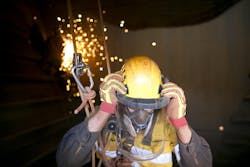Tech and Worker Safety During COVID-19
By Emily Folk, Technology Writer
The COVID-19 pandemic has disrupted almost every industry in the world. Its effects are deep-rooted and require that businesses and individuals adjust to a new normal concerning safety. Primarily, social distancing at all times is a necessity that will not be going anywhere anytime soon. To adapt to these changes, plumbing and HVAC businesses will need to turn to technology.
Worker safety is a top priority for all businesses. While working during the coronavirus, it is now harder to remain safe on the job due to how quickly this respiratory illness spreads. However, technology like video calling, for instance, is simple and can go a long way in protecting both workers and clients.
Remote Inspections
In a pre-COVID-19 world, a consultation or inspection for heating and cooling, plumbing or any other contracting work would look much different than it does now. Social distancing guidelines state that individuals must remain at least six feet apart from one another.
Due to this mandate, working with clients in their homes or offices is difficult. Often, plumbing inspections and diagnostics occur in small spaces where staying six feet apart would not be possible. Instead, professionals should offer services through video calling platforms. Something as simple as FaceTime, Skype or Zoom will suffice.
The client can show the areas that need repairs, replacements or new installations. Then, workers can gather the necessary supplies and tools ahead of time. That way, there will not be a need to travel back and forth during the job.
Limiting face-to-face contact and time spent inside a client's home is key. However, clients may not know what the issue is that needs servicing. In these instances, workers will need to go to the location.
Communication
Off-site communication with clients is a necessary part of the new normal. Extending those same virtual practices to staff and supervisors on- and off-site is also critical. First, however, workers must wear COVID-19 personal protective equipment (PPE). Masks, gloves and any other coverings count as PPE. Washing hands frequently with antibacterial soap and water for at least 20 seconds is also necessary—especially on-site.
Then, while working, the clients should remain out of the house or in a different location to minimize contact. If the job requires multiple workers, they should social distance as well. Here is where technology will help keep everyone safe.
If two people are working at one location, calling or video chatting helps them solve problems. When one worker has an issue, they can call the other and show them the situation. Apply this concept to supervisors, too, and workers can get real-time assistance. Social distancing is possible with the help of simple technology solutions.
This form of contact also reduces the amount of time on projects. Faster communication is safer and more efficient than making several trips.
COVID-19 Monitoring
Worker safety involves staying on top of the latest COVID-19 information. With different states in the U.S. seeing increasing and decreasing numbers of cases, it is important to remain up to date with the fluctuations. Additionally, new information about the spread of the virus and ways to best protect workers comes through frequently.
For the time being, wearing PPE, social distancing and frequently washing hands are the best steps to take at all times—not just when on the job. However, in professions like plumbing, extra protection and caution may be necessary. Dealing with waste that carries potential pathogens and germs is part of a plumber's job.
Extra sanitation is now a necessity to stay safe. This can occur through technology—like wearables to track health and vitals—or new standard cleaning methods, like using UV-C light (a type of ultraviolet light).
Further, contact tracing or using smart COVID-19 analytics within the company is a helpful route to take. While states are implementing contact tracing programs, an employer can monitor anyone who contracts the virus or has symptoms. Then, they can alert anyone they came in contact with and advise them to reach out to their primary care physician.
Security Protocols
Regarding technology in the coronavirus era, there are many threats in the cyberworld. During the pandemic, scams and breaches have increased overall. Anxieties are running high, which creates an ideal territory for cybercriminals. For businesses of any size, this increased cybercrime can lead to a loss of client or employee information as well as stolen money.
Staying safe during COVID-19 applies to both the physical and financial realms. If a business takes a hit, so do the workers. Investing in improved cybersecurity systems will keep everyone safe in the long run. Additionally, avoiding suspicious content or emails is a primary way to prevent breaches.
The Recurring Theme
During COVID-19, there is a recurring theme of communication and technology providing safety. Whether it is remote video calling or staying in touch about health conditions, technology provides socially distant methods for all types of communication. With the right integration of technology in each of these areas, professionals can continue business operations and adjust to the new normal.
Emily Folk is a green tech writer who covers topics in renewable energy and sustainable design. You can read more of her work on her blog, Conservation Folks.
